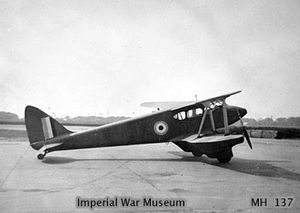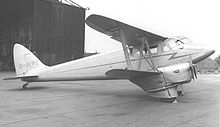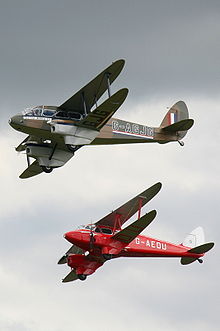De Havilland Dragonfly Video - Landing
|
|
De Havilland Dragonfly
DH.90 Dragonfly

Picture - R.A.F de Havilland DH.90 Dragonfly AW164 (ex-G-AEDK) at R.A.F Gosport
Role: Light Transport
Manufacturer: De Havilland Aircraft Company
First flight: 1935
Introduced: 1936
Number built: 67
The de Havilland DH.90 Dragonfly was a 1930s British twin-engined luxury touring biplane built by De Havilland Aircraft Company at Hatfield Aerodrome.
Development
The Dragonfly shared a clear family resemblance with the Dragon Rapide, but was smaller and had higher aspect ratio, slightly sweptback wings. The lower wing had a smaller span than the upper, unlike the DH.89 and the top of the engine nacelles protruded much less above its surface because the fuel tank had been moved to the lower centre section. Structurally, too they were different: the Dragonfly had a new pre-formed plywood monocoque shell and strengthened fuselage. It was designed as a luxury touring aircraft for four passengers and a pilot, with provision for dual control. The first aircraft, G-ADNA first flew on the 12 August 1935. The Dragonfly achieved the maximum performance on low power by using the new construction methods developed for the de Havilland Comet racer and therefore was expensive to buy (£2,650). In modern terms it was an executive transport, aimed at wealthy private individuals often via the companies they owned.
Operational history
ref=
The first delivery was made in May 1936. Some 36 new build Dragonflies went to private and company owners, about 15 to airlines/air taxis and three to clubs. Two each went to the Danish and Swedish airforces, and the Royal Canadian Mounted Police had four to combat rum-runners. Production ended in 1938.
By 1939, several aircraft had moved from private to commercial use, like the fleet built up by Air Dispatch Ltd at Croydon (Mrs V. Bruce). Amongst her seven were also some ex-airline machines. They were used as air taxis between the various London airports and also as Army Co-operation night flying trainers. Western Airways of Weston-super-Mare used their Dragonfly on their scheduled service via Birmingham to Manchester.
Seven airframes were shipped to Canada and erected by de Havilland Canada, where they served a variety of small commercial operators, the R.C.M.P. and two with the R.C.A.F. One at least, CF-BFF, was mounted on Edo floats and used commercially.
Three Dragonflies were bought by the Romanian government in about 1937 for crew training, appearing on their civil register.
At the start of World War II, about 23 Dragonflies were impressed into the R.A.F and Commonwealth airforces, some six surviving to 1945. Overall, there were about thirteen flying in that year.

Picture - Dragonfly used by Silver City Airways as an executive transport in 1953
Silver City Airways operated a Dragonfly G-AEWZ as an executive transport from 1950 until 1960. By around 1970, only the two survivors noted below were active.
The fuel tanks in the Dragonfly were in the thickened lower centre-section, not immediately behind the engines as in the Dragon Rapide. As a result, only one aircraft was lost to fire. A common cause of loss was the frequent development of a vicious ground loop either in take-off or landing, resulting in undercarriage write-off and spar damage.
Variants
DH.90: First prototype only. Two 130hp (97kW) de Havilland Gipsy Major I
DH.90A: Two 142hp (106kW) de Havilland Gipsy Major 1C or D (postwar, essentially identical) or the earlier, very similar Major II in prewar aircraft.
Dragonfly Seaplane: the addition of the aluminium floats, strengthened attachment points, extra cabin door and wing walkway increased the empty weight to 3,110lb (1,410kg) and lowered the maximum speed to 125mph (200km/h)
Survivors

Picture - De Havilland DH.89 and DH.90
Two flyable aircraft survive:
DH 90A ZK-AYR (c/n 7508) is operated on scenic and aircraft experience flights by the Croydon Aircraft Company in New Zealand. It was first registered as G-AEDT, then went to Australia as VH-AAD and to the USA as N2034. From about 1988 to 1996 it was flying as G-AEDT again, before leaving the UK for New Zealand.
DH 90A G-AEDU (c/n 7526) has been registered in the United Kingdom since 1992, owned by the Norman Aeroplane Trust.. Originally delivered to Angola in 1937, it flew as CR-AAB and later as ZS-CTR in South Africa. When it was returned to England in 1979, it used a British registration (G-AEDU) that had been allocated to another Dragonfly but not used. It was exported to the United States in 1983 as N190DH but it was returned to England in 1992 in a damaged state and rebuilt to flying condition as G-AEDU.
Former operators
Australia
QANTAS
Royal Australian Air Force
Canada
Royal Canadian Air Force
Royal Canadian Mounted Police
Denmark
Royal Danish Air Force
Egypt
Misr Airwork Ltd
India
Air Services of India Ltd
Iraq
King Faisal of Iraq
Netherlands
Dutch Army Aviation Group
New Zealand
Air Travel (NZ) Ltd - Two aircraft only.
Peru
Peruvian Air Force
Rhodesia
Rhodesian and Nyasaland Airways
Romania
LARES
South Africa
South African Air Force
Sweden
Royal Swedish Air Force
Turkey
Devlet Hava Yollari
Uruguay
PLUNA
United Kingdom
Air Dispatch Ltd
Air Commerce Ltd
Air Service Training Ltd
Air Taxis Ltd
Anglo-European Airways Ltd
Birkett Air Services Ltd
British Continental Airways Ltd
International Air Freight Ltd
Plymouth Airport Ltd
Royal Air Force
Silver City Airways Ltd
Western Airways Ltd
Specifications
Data from
General characteristics
Length: 31 ft 8 in (9.65 m)
Wingspan: 43 ft 0 in (13.11 m)
Height: 9 ft 2 in (2.79 m)
Wing area: 256 ft² (23.78 m²)
Empty weight: 2,500 lb (1134 kg)
Max takeoff weight: 4,000 lb (1814 kg)
Powerplant: 2x— De Havilland Gipsy Major II inverted inline piston engine, 142 hp (109 kw) each
Performance
Maximum speed: 144 mph (232 km/h)
Range: 625 mi (1,000 km {at full load; a 25 gal/95 tank in the rear cabin increased range to 900 mi/1,440 km})
Service ceiling: 18,100 ft (5,515 m)
Rate of climb: 875 ft/min (4.5 m/s)
The Illustrated Encyclopedia of Aircraft (Part Work 1982-1985). London: Orbis Publishing.
Hayes, P & King, B. de Havilland biplane transports. Coulsden: Gatwick Aviation Society (2003) ISBN 0 95304132 8
Jackson, A.J. British Civil Aircraft since 1919, Volume 2. London: Putnam, 1973. ISBN 0-37010-010-7 or (1988 revision) ISBN 0-85177-813-5.
Jackson, A.J. De Havilland Aircraft since 1909. London: Putnam, 1978 ISBN 0 370 30022 X
Grey, C.J. and Bridgman, L, Jane's All the World's Aircraft (1938). London: Sampson Low Martin.
Living Warbirds: The best warbirds DVD series.
Source: WikiPedia